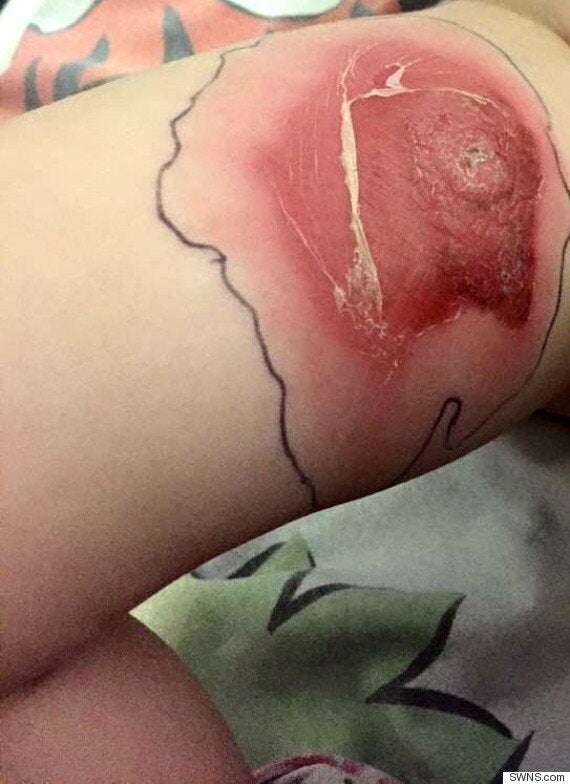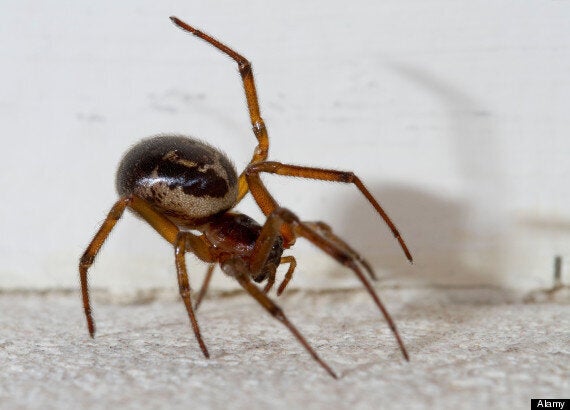A three-year-old girl spent three days in hospital and was unable to walk after being bitten on the leg - by a false widow spider.
Toddler Ella Williamson developed an eight-inch blister from the tiny bite by Britain's most venomous arachnid, which took more than three months to heal.
Ella's distraught mother Bobbie-Louise Willis rushed the little girl to hospital after the bite mark tripled in size over two days.

Ella Williamson was hospitalised after being bitten by a false widow spider
She spoke out as experts warned the weather was ripe for a "population boom" of the creepy crawlies.
Full-time mum Bobbie-Louise, 24, from Dover, Kent, said: "It was the worst time of my life. I thought something was eating her from the inside. It just kept getting bigger.
"She wouldn't let me touch it. So she must have been suffering in pain. I would hate to see anyone go through what she went through."

The bite caused an eight-inch blister
Ella had being staying with her father Matthew Williamson, 28, in Folkestone, Kent, when the false widow spider sank its fangs into her leg.
Bobbie-Louise first noticed Ella had a small blister when she returned home on March 22, and took her to hospital the next morning after the bite doubled in size.
Bobbie-Louise said: "She was given antibiotics and sent home, but the day after it had tripled in size and looked like her leg was being eaten away.

Six species of false widow spider have been recorded in the UK
"I took her back to hospital as she was being sick and was really poorly. I was very worried, at first I thought it might be meningitis, so horrible thoughts were going through my head.
"We waited for a skin specialist, who said it was a false widow spider bite.
"She couldn't walk and had to be carried everywhere. It was horrible to see my daughter in that way."
Ella was sent to the William Harvey Hospital in Ashford, Kent, where she was given a bed and put on strong antibiotics.
It took a month before the scabbing started to get better, and three months for it to heal completely.
Ella has no permanent scarring, but is now terrified of spiders.
SEE ALSO:
Bobbie-Louise, who caught a false widow a year before the attack, said: "I always used to put spiders outside, but after seeing what Ella went through I would definitely kill one straight away now."
False widow spiders, which are frequently confused for the deadly black widow, are set to invade British homes in the coming weeks due to warm weather.
The spiders - Steodata nobilis - are related to the black widow, but do not have the distinctive red spot on their backs. They make similar "tangle" webs, which are full of eggs, making it likely for many spiders to be in the same small area.
Unlike the black widow, the false widow spider is known to live in Britain and was first spotted in Devon in the late 1800s.
It tends to populate the coastal areas of southern England and London and it is likely the increase in its numbers is in response to climate change.
According to Stuart Hine of the Natural History Museum's (NHM) Insect Information Service, no one has ever died of a spider bite in Britain and the number of reported bites from spiders in general is minimal.
The false widow is amongst only a dozen or so of the UK's 650 species of spider that are capable of biting humans.
The NHM says reports from people believed to have been bitten by the false widow describe varying levels of burning, discomfort or numbness and associated swelling in the area surrounding the bite.
Symptoms usually disappear within one to three days, though some like Blackburn have experienced severe reactions to the arachnid's venom.